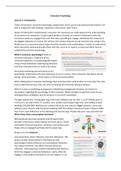Samenvatting
Summary of consumer psychology all lectures and articles
- Instelling
- Rijksuniversiteit Groningen (RuG)
All the relevant articles and lectures for the exam. Also includes print screens from the slides/lectures. So, also all the articles are summarized!
[Meer zien]




